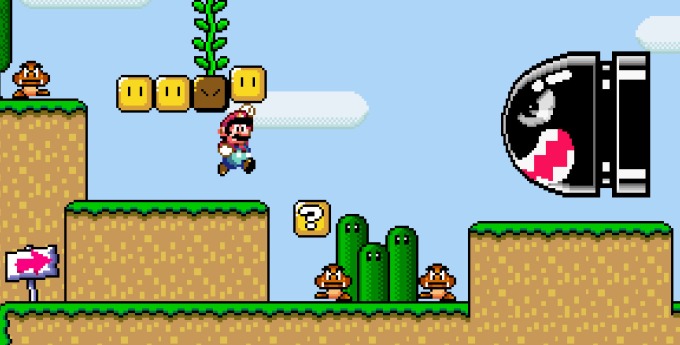OVERVIEW

Overview
Super Mario World is a two-dimensional platform game in which the player controls the on-screen protagonist (either Mario or Luigi) from a side view. The game shares similar gameplay mechanics with previous game titles in the series-Super Mario Bros., Super Mario Bros. 2, and Super Mario Bros. 3-but introduces several new elements. In addition to the operating and jumping techniques found in past games, the gamer can float with the aid of special items and execute new types of jumps like the spin jump.
The gamer navigates through the game via two game displays: an overworld map and a sidescrolling playfield. The overworld map shows an overhead representation of the current world and has several paths leading from the world's entry to a castle. Pathways hook up to action sections, fortresses, ghost properties and other map icons, and invite players to use different routes to attain the world's goal. Moving the on-screen identity for an action -panel or fortress allows usage of that level's playfield. A lot of the game occurs in these levels, populated with road blocks and enemies, with the participant traversing the level by jogging, jumping, and dodging or defeating enemies. The participant is given a degree of lives, that are lost when Mario is attacked by an adversary while small, comes into a pit or lava, or works out of time. If all lives are lost at any point in the overall game, the "Game Over" display screen will appear, where the player can continue from the previous level enjoyed by selecting "Continue". Each world includes a last level with a supervisor to defeat; each one of the seven worlds feature fortresses manipulated by one of the Koopalings, and the participant also fights Bowser in his castle in the seventh world. Furthermore to special items from past game titles like the "Super Mushroom" and "Flame Rose", new power-ups are created that provide the participant with new gameplay options. Furthermore, the "Spin Strike" jump is initiated with the "A" button. The spin strike allows Mario or Luigi to break blocks beneath him.
The new suit in the game is the cape feather, which gives Mario a cape and allows him to fly. This suit is also similar to the Tanooki Suit from Super Mario Bros. 3 in terms of gameplay mechanics but with a few alterations: the gamer can now hold the B button to take flight when Mario is able to achieve this, and can glide using the cape as a sail. However, the Super Leaf, Tanooki Suit, Frog Suit, and Hammer Suit power-ups from Super Mario Bros. 3 did not return. The game also released the ability to "store" an extra power-up in a container located at the top middle of the display. For example, if Super Mario obtains a Fireplace Blossom or Cape Feather or picks up another Super Mushroom, a Mushroom is stored in the container. If Cape Mario confirms a Fire Rose, a Cape Feather will be stored in the pack. The power-up can be released by pressing the Select button or will automatically deploy if Mario is struck by an adversary.
The overall game introduces Yoshi, a dinosaur companion whom Mario can ride and who's in a position to eat most enemies. If Yoshi makes an attempt to consume a Koopa or its shell, he'll carry it in his oral cavity for a time frame before swallowing it; Yoshi can also spit out the shell, that will work as if kicked by Mario. Yoshi profits special talents while retaining a shaded shell in his oral cavity: a blue shell permits Yoshi to take a flight, a yellowish shell triggers Yoshi to produce particles clouds that wipe out local enemies, and a red shell allows Yoshi to create three fireballs. Blinking Koopa shells produce all three ability, while inexperienced shells produce nothing. The default Yoshi is inexperienced, however the game also includes blue, yellowish, and red Yoshis; the participant can buy each Yoshi by finding its egg in Legend World and nourishing enemies to it until it matures. When retaining any Koopa shell in its oral cavity, a Yoshi benefits the ability that corresponds to its own color, in addition to that of the shell.
Super Mario World includes a multiplayer option which allows two players to learn the game by alternating turns at navigating the overworld map and accessing stage levels; the first player handles Mario, while the other handles Luigi. Although Mario and Luigi must generally navigate through seven worlds to reach the end of the game, the gamer can beat the game much faster by using the Celebrity Road routes. In addition, there are a number of levels which have concealed exits, so Mario can navigate Bowser's castle in several ways. Furthermore, the exploration of these secret stages can lead to other phases, such as Special World. Completion of Special World forever alters some sprites and the overworld map's color structure.

0 nhận xét: